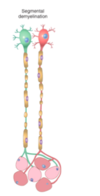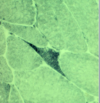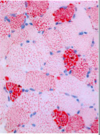PNS/Muscle Flashcards
PNS/MUSCLE I
What is happening to the nerve in the image?

Segmental demyelination
•Schwann cell dysfunction or myelin sheath damage
•No primary abnormality of axon
•Not all Schwann cells along length of axon involved
•Degenerating myelin engulfed by Schwann cells later by macrophages
•Denuded axon induces remyelination by stimulating Schwann cell stem cell proliferation
What pathology do you see in this image? Explain.

- Segmental demyelination: Axon in the top right should be myelinated
- Same size as the two heavily myelinated axons in the bottom of the image
What is occuring in this axon?

Repeated bouts of demyelination and remyelination results in multiple layers of Schwann cells surrounding axon giving it an onion bulb appearance – onion bulb neuropathy
What is occuring? Primary and secondary findings?

Axonal degeneration
•Primary destruction of axon
•Secondary degeneration of myelin sheath
•May be focal destruction or generalized insult
•Response to transection or focal lesion
•Wallerian degeneration
Wallerian degeneration comes from focal damage and the axon may break down within a single day. Chromolysis (loss of nissl bodies) and perikaryon swelling occurs and the schwann cell begins to digest myelin. Denervated muscle cells atrophy
What can you see in this image?

Top middle clustering:
Suggestive of resprouting of axons (multiple)
The thinness of the myelin implies that this is a recent event
What are these?

Regeneration cluster – Growth cone
- Multiple filipodia/lamellapodia lead small caliber axons
- These are closely aggregated and thinly myelinated
- They typically follow the cord of Schwann cells
- Slow axonal transport: grow only 1mm/day
- Limit = slow rate of transport from synthetic activity in the nucleus
What disease is this associated with?

Guillain-Barre Syndrome
- Can see inflammation (at the top) of the peripheral nerve with perivenular and endoneural infiltration of lymphocytes, macrophages and a few plasma cells
- Commonly motor roots of spinal and cranial nerves
- Macrophages penetrate at the nodes and peel away the myelin layers
What disease is this a typical stain for?

Leprosy: cellular immune response determines which morphology
- Lepromatous leprosy - Schwann cell invaded by bacteria causes segmental demyelination/remyelination, loss of both M/UM fibers, and endoneurial fibrosis and thickening of perineural sheaths
- ——–symmetric polyneuropathy with primarily sensory loss in cooler extremities
- Tuberculoid leprosy - active cell-mediated response - nodular granulomatous inflammation in dermis injuring cutaneous nerves, perineural and endoneurial fibrosis
- ——more localized nerve damage of axons, Schwann cells, perineural and endoneural layers
What is this image associated with? What is this stain for?

This is also leprosy
This stain is for bacterial cells in the endoneurium. Acid fast positive lepra bacilli
What is this?

Diptheria - Corynebacterium diphtheriae
- Gram positive rod with clubbed ends
- Exotoxin initially effects peripheral nerve and causes paresthesias and weakness
- Characteristic early loss of proprioception and vibratory sensation
- Toxin enters sensory ganglia due to incomplete blood-nerve barrier
- Demyelination extends into adjacent anterior and posterior roots
- mixed sensorimotor nerves
- A toxin blocks protein synthesis by adding ADP-ribose to elongation factor 2
This one is tricky: what is going on here?

Adult Onset Diabetic Neuropathy
- Arrowheads only
- large axon with a thin sheath indicating an ongoing process
- Arrow
- vascular changes here with duplication of the basement membrane
- Mechanism is thought to be advanced glycation end products
- Most commonly ascending distal symmetric sensorimotor neuropathy
- Loss of small M and UM fibers
- Large fibers also affected - those remaining have less myelin
- Endoneurial arterioles show diabetic vascular thickening
PNS/MUSCLE II
What disease is this image associated with?

Charcot-Marie-Tooth 1
- AD inheritance in childhood/early adulthood
- Repeated segmental demyelination –> onion bulbing
- Hypertrophy of individual peripheral nerves
- May have palpable nerve enlargement
- Distal leg weakness and progressive muscular atrophy of the calf (peroneal muscular atrophy)
- Pes cavus
What is this? What be happenin?

This is the result of axonal degeneration and denervation
Myofibers that lose their innervation become angular and shrink. At an extreme stage of atrophy virtually all the sarcoplasm is lost and the myofiber is reduced to a cluster of nuclei. No myonecrosis



















